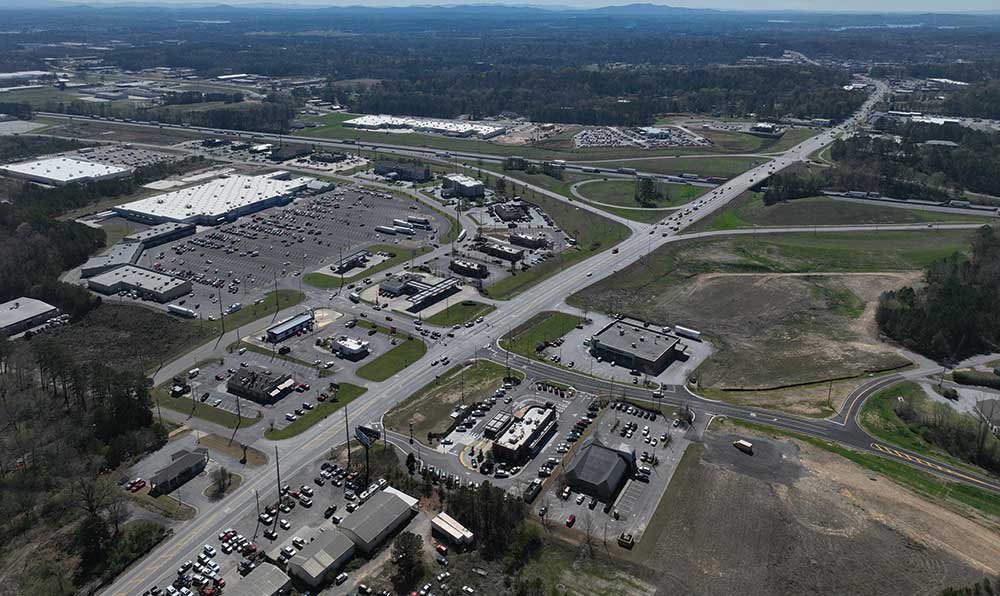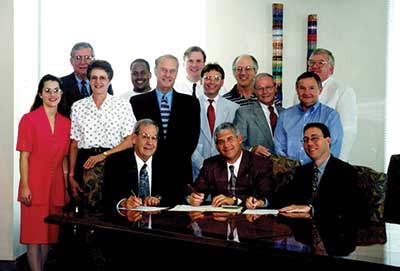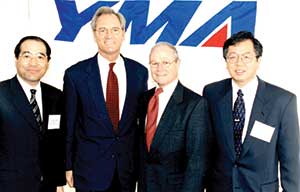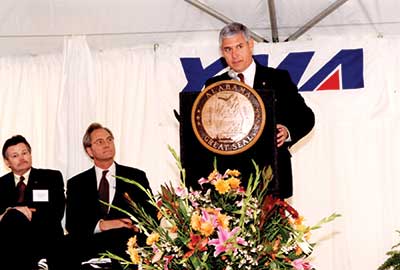
A spark illuminates a 25-year path forward
Story by Carol Pappas
Photos by David Smith
Discover Archives photos
It’s called a tipping point – that moment when an idea catches a spark and spreads – much like the momentum of a wildfire.
It is exactly that point where St. Clair County found itself 25 years ago with nothing more than an idea of how economic development could work for the future. This was the crossroads question: Do it the way it’s always been done or venture outside the box and bring an entire county together toward a common goal?

Lucky for St. Clair County, officials chose the latter, it took hold, and it’s been spreading like wildfire ever since.
You might say it was luck when the St. Clair Economic Development Council was created, but those who were there at those historic crossroads know differently. Those groundbreakings and ribbon cuttings that have become virtually a weekly routine around these parts today did not happen by accident.
Like laying a foundation brick by brick, a group of visionaries carefully transformed an idea into what St. Clair Countians may take for granted these days. But it was all part of a strategically laid plan.
For years, Pell City Realtor Ed Ash assumed responsibility for economic development and by all accounts is owed a debt of gratitude. Many of the early industries were recruited and the projects landed because of Ash’s efforts.
In about 1998, he decided to retire from industry recruiting, and officials faced a decision. What do we do next?
“We figured we needed a full-time recruiter,” said Bob Barnett, who serves as chairman of the Pell City Industrial Development Board, a post he still holds. But they wanted to take it a step further – make that several steps – and develop it as a countywide effort. “It was an idea that just started taking wings. Everyone saw the need.”
Barnett and then commission chairman, the late Roy Banks, are credited with giving the idea those wings early on.
They enlisted the counsel of Circuit Judge Bill Weathington, who was county attorney and Moody city attorney at the time, and he skillfully set up the framework of what would become the EDC. Municipalities came on board, and the idea was in motion.
“One thing we realized was in order to get economic projects, we needed to incentivize differently to compete with surrounding counties and larger municipalities,” Weathington said. “We determined that together, we could compete.”
“Together” is a recurring theme throughout this 25-year success story. Up to that time, municipalities operated from their own silos, sometimes competing with each other.

The new concept meant they could compete effectively with others outside the county rather than battling among themselves. What was good for one was good for all.
“We could do things we could not do individually, and if we helped each other, we could help the county have a better chance of landing some of these things,” Weathington said.
With over 8,000 new jobs and $1.7 billion in new investments to its credit since that time, Weathington concluded, “it turned out pretty well for us.”
Banks was a driving force early in the planning, urging Weathington to structure it so that it would be “fair for everybody,” he said. As history would have it, Banks was defeated that year for the chairmanship by Stan Batemon.
But Batemon, recognizing the importance of the effort, not only kept it going in his administration, he and the commission appointed Banks as a member of the first EDC Board of Directors. The structure of the board was critical to the ‘together’ plan. Representation on the five-member board was spread around the county, and no elected official was allowed to serve, a move aimed at keeping politics out of the process.
The charter board was Tommy Bowers, Pell City, chairman; Terry Stewart, Ashville; Joe Kelly, Moody; Lyman Lovejoy, Odenville; and Banks, Pell City. The county commission gave the first $100,000 to fund it, and each municipality invested based on a percentage of their population.
The structure of the board has remained the same. “It still functions like it was set up,” Weathington said. “It speaks well” that the boards, mayors, council and county worked together across administrations to ensure the continuity of mission. “You don’t find that everywhere,” he said.
Weathington noted that Barnett was involved in bringing the idea to the table and played an instrumental role in “making this happen.” Banks, he said, guided the process. And Batemon was the “salesman, made us look good and sold a lot of people on St. Clair County.”
Sibling rivalry thwarted
The biggest fear at the beginning was that the first major project would go to Pell City rather than another municipality and endanger the concept of working together. But it went to the tiny town of Steele in the northern tip of St. Clair County, which landed a Saks Fifth Avenue distribution center.
In fact, the second project went to Steele, too – Yachiyo, an automotive supplier.
Former Pell City Mayor Guin Robinson followed the late Mayor Mack Abercrombie into office in the early goings of the EDC. Recognizing that locating the first industry outside Pell City would actually help the overall, long-term success, he recalled telling former Executive Director Ed Gardner Sr. that it would not hurt his feelings if the first project landed elsewhere.
When the second project went to Steele, he told Gardner in jest, “Hey, Ed, I didn’t mean they all had to be outside Pell City.”
Robinson’s tenure eventually saw plenty of growth. The expansive Walmart development, Jefferson State Community College and a host of other industrial, commercial and institutional projects dotted the landscape.
Now Dean of Economic Development at Jefferson State Community College, Robinson has a rare vantage point as councilman, mayor and college official. The EDC is headquartered on the third floor of Jefferson State. “At that time, the community recognized the importance of the future of the EDC, and Jeff State recognized that as well.”
During the late Jefferson State President Judy Merritt’s term, the college expressed its desire to locate EDC there if space was available. “Judy Merritt and her team, which included current President Keith Brown, embraced the idea. Making that decision before the building was even built says a lot about the importance of EDC and its future.”
Robinson referred to the college’s mission of economic development and workforce development as a “natural fit” with EDC’s own mission and what would become a solid partnership.
Other areas of the county found natural fits, too, because of the strong foundation EDC was building. Moody saw Red Diamond, a global coffee and tea manufacturer pull up its 100 year-old roots in Jefferson County and head to St. Clair County, building a stunning facility there and making sizable initial and subsequent investments in expansions and generating significant job growth.
In its 25 years, every area of the county has benefited from new or expanding industry investment as well as commercial ventures, a testament to their working together philosophy.
First hire
The EDC Board’s first decision set the course. Maybe the stars were aligned just right, as they say, or more probably, it was the vision shared by those who made it happen.
Ed Gardner Sr. was serving as head of the Alabama Department of Economic and Community Affairs in Gov. Fob James’ administration and was leaving office. He previously served as assistant secretary of Housing and Urban Development in Washington D.C.
His contacts and relationships in business and government circles were legendary. “If we could get him,” Lovejoy recalled, it would make all the difference. They hired him, and it did make all the difference.
When Gardner was honored by EDC in 2018 with its Chairman’s Award, Robinson remarked, “You can have all the necessary things for success, but it takes a leader. And it takes someone who can put all the ingredients together. You can call him an architect. You can call him a builder, but Ed put it together. … We all knew we had those things, but we needed someone to put it together. I’m forever thankful and forever grateful that that person was Ed Gardner.”
“Boy, did we hit a homerun,” Lovejoy said. Gardner had a working relationship with Metropolitan Development Board in Birmingham. He knew people to contact, not just in the state but around the country. He made the wheels turn. We were at a running gallop right off.”
Directors lineage
That gallop never seemed to let up. When Gardner retired, the board hired his son, Ed Gardner Jr., who was deputy director for economic development for the City of Auburn. At the time, Auburn was viewed by many as the pinnacle of economic development in the state.
He stepped into the role, and more successes followed. The first German industry – Eissmann Automotive put its first North American plant in Pell City. That led to VST Keller Oerlikon. Gardner, Jason Goodgame of Goodgame Company and Batemon traveled to Germany to help swing the deal. That led to WKW locating in Pell City as well. Today, Eissmann and WKW are St. Clair County’s largest employers.
Before he left, the wheels were in motion for the other two components of a trifecta for institutional growth in Pell City – Ascension St. Vincent’s St. Clair and Col. Robert L. Howard Veterans Home joined Jefferson State Community College – on the sprawling site fronting Interstate 20.
Gardner would oversee tremendous growth in the county over his five-and-a-half-year tenure.
During those years, he guided a fundraising campaign that saw the EDC budget grow from $200,000 a year to $2.5 million over five years. He hired an assistant director, Don Smith, and a retail specialist, Candice Hill, so that EDC could focus fully on all facets of economic development.
Smith was a former colleague from Auburn. When Gardner left the City of Auburn, he said he told Smith, “Hang out here and learn a little bit, and I’ll come back and get you.”
Fortunately for him and St. Clair County, he did. Smith became assistant director for the EDC and later executive director. Gardner Jr. left in 2010 for the Birmingham Business Alliance and later Power South, and Smith ascended to the role he has held ever since.
“It was the best decision of my career,” Smith said. At EDC, he worked as assistant with Gardner Jr. for one and a half years and then served as interim director for six months before being named executive director.
Groundbreakings for the hospital and the veterans home came at the beginning of his taking the helm. Scores of industrial and commercial developments have followed, and they show no signs of slowing.
His innovative and strategic thinking have given birth to new initiatives – Tourism, led by Coordinator Blair Goodgame, and Leadership St. Clair County and a newly created Grant Resource Center, led by Candice Hill, director of Grants and Leadership. He named Jason Roberts director of Industry and Workforce Development.
“Don is forward thinking,” said former EDC Chairman Tommy Bowers. “He has a great team.”
Looking to the future from the lofty position of $233 million in new annual wages announced to date, Smith and his team are poised to announce 1,200 new jobs and $350 million in new investment over the next five years. It is a target they are already on track to exceed.
Lovejoy’s assessment was right. EDC hit a home run indeed.
















